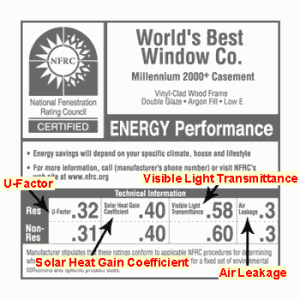 The National Fenestration Rating Council (NFRC) energy performance label allows you to compare one window with another in terms of resisting heat buildup in summer, warming your house in winter, keeping out wind, and resisting condensation.
The National Fenestration Rating Council (NFRC) energy performance label allows you to compare one window with another in terms of resisting heat buildup in summer, warming your house in winter, keeping out wind, and resisting condensation.
Defining the Ratings
U-Factor
The U-factor measures how well a window prevents heat from escaping. The rate of heat loss is indicated in terms of the U-factor (U-value) of a window assembly. A U-factor is the inverse of an R-value. If you divide the U-factor into 1 you get the equivalent R-value. U-factor ratings generally fall between 0.07 and 1.20. The lower the U-value (the higher the R-value), the greater a window’s resistance to heat flow and the better its insulating value.
For example, a U-.33 = R -3 (typical for low-e windows); a U-.50 = R-2 (typically for double-glazed windows).
Solar Heat Gain Coefficient
The solar heat gain coefficient (SHGC) measures how well glass blocks heat in sunlight. The SHGC is the fraction of solar radiation admitted through a window (both directly transmitted and absorbed) and released inward or how much heat gain is blocked by the window. SHGC is expressed as a number between 0 and 1. The lower a window’s solar heat gain coefficient, the less solar heat it transmits in the house. The lower the number, the better for east and west windows; the higher the number, the better for south windows.
Visible Transmittance
Visible transmittance (VT) measures how much light comes through a window. VT is expressed as a number between 0 and 1. The higher the VT, the more visible light is transmitted.
Note: If retrofitting windows on the same side of a house with existing windows with a different VT number, they will will look different from both inside and outside.
Air Leakage
Air Leakage (AL) is indicated by an air leakage rating expressed as the equivalent cubic feet of air passing through a square foot of window area (cfm/sq. ft). Heat loss and gain occur by infiltration through cracks in the window assembly. The lower the AL , the less air will pass through the cracks in the window assembly. This number is important to the airtightness of the building.
Condensation Resistance
Condensation Resistance (CR) measures the ability of a window to resist the formation of condensation on the interior surface. The higher the CR rating, the better the window is at resisting condensation formation. Although this rating cannot predict condensation, it can provide a credible method of comparing the potential of various windows for condensation formation. CR is expressed as a number between 0 and 100. Each surface glazing raises the CR of the window. Super-windows have a very high CR.
Courtland Building Company would love to help you plan your green home, call us today: (281) 932-4494
Visit our website: www.courtlandbuildingcompany.com Follow Us on Facebook – Twitter – LinkedIn


